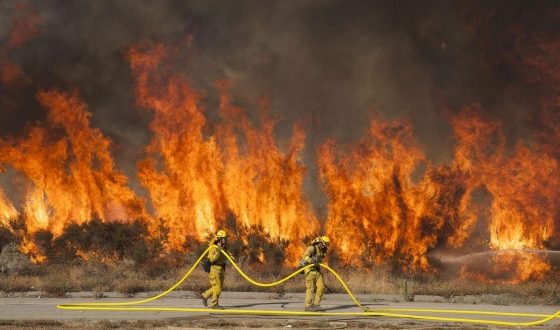Wildfire Fears made Real by Southern California's Drought Dry Brush
Published on August 30th, 2016
Cal Fire firefighters battle flames along side Cajon Boulevard while fighting the Blue Cut fire off Interstate 15 on Wednesday. The fire was fuel by extremely dry brush thanks to five years of drought.
By David Danelski
August 30, 2016
The Press Enterprise
As the Blue Cut fire raged out of control in the San Bernardino Mountains one fire commander described the chaparral brush fueling the blaze as a kind of living dead.
“It was green vegetation, but it burned like it was dead,” said San Bernardino County Fire Chief Mark Hartwig.
Pushed by moderate prevailing winds, the fire’s front Aug. 17 rapidly expanded to about a mile wide. Firefighters soon found themselves dividing their limited resources to protect homes and other structures at not one, not two, but five locations.
More than a hundred homes burned before firefighters gained control.
The last time the fire chief saw a wildfire move so fast was in 2003, when the deadly Old and Grand Prix fires devastated much of San Bernardino Mountains. But those fires were fanned by much stronger Santa Ana winds, he said.
A big factor in the latest fire is what the chief described as critically low moisture levels in the manzanita bushes and other woody shrubs in the chaparral habitat that grows in the foothills of Southern California’s mountains.
Usually the brush isn’t this dry for another two months. This situation helped spark this year’s early start to the season, which began June with two fires northwest of Azusa. And, in the case of Blue Cut fire, a rapid rate of expansion.
And now Southern California firefighters are on heightened alert for more.
DROUGHT IMPACT
Experts blame today’s parched chaparral on five years of drought exacerbated by a warming planet. The sun-loving manazitas and other shrubs normally soak up the cool-season rains and spring snow melts, and thrive with new growth until the hot and dry days of summer arrive.
Then, to save water, they go dormant, a state not much different than animals in hibernation.
Pores on their leaves close. Their rate of respiration and photosynthesis drops, and they hang until the next rainy season. The cycle has gone on for eons, explained Jon E. Keeley, a research ecologist with the U.S. Geological Survey.
As the summer progresses, the water content in these shrubs drops, usually making early fall the most risky time for chaparral fires.
But things are different this year.
The water content in the Southern California chaparral already has dropped to fall levels, thanks five years of drought, said Tom Rolinski, a Riverside-based meteorologist for the U.S. Forest Service.
While several rain storms hit California last fall and winter, most of the storms swung north, denying the Southern California chaparral a much-needed soaking. Instead, our region got another year of below normal rainfall, Rolinski said.
Not only is the living plant tissue drier, but the shrubs also are carrying more dead wood, added Ileene Anderson, a wildlife biologist with the Center for Biological Diversity who has expertise in Southern California native plants.
The years of drought also have caused the chaparral to expand to areas where parched pine trees are dying off because of drought and bark beetle infestations, Anderson said.
“The chaparral is moving up slopes and more northward,” she said.
GLOBAL WARMING
Climate change appears to be making this fire hazard worse.
Earlier this month, the National Aeronautics and Space Administration reported that July’s average worldwide temperatures made it the hottest month since people began recording temperatures. The picture was a bit different in Southern California, where the hottest July on record was logged in 2006, according to National Weather Service data.
Ben Cook, a climate scientist at NASA’s Goddard Institute for Space Studies in New York, said by telephone that Southern California, like the rest of the world, is on a warming trend.
He acknowledged that California went through periods of drought before climate change. But warming means our droughts will start earlier, be more severe, and last longer, he said.
“As long as there is fuel to burn, an increase in temperatures will mean more wildfires,” Cook said.
He added, “As long as we keep pumping greenhouse gases into the atmosphere, we are going to see continued warming in the future.”
A SUMMER OF SOUTHERN CALIFORNIA WILDFIRES
Blue Cut fire
Started: Aug. 16, 2016
Location: Cajon Pass area of the San Bernardino Mountains.
Terrain: Chaparral, grassland and timber
Size: 36,274 acres
Damage: 105 single family homes, 216 outbuildings were destroyed. Three single family residences and 5 other structures were damaged as well as guardrails in Interstate 15.
Pilot fire:
Started: Aug. 9
Location: near Silverwood Lake, south of Hesperia, in the San Bernardino Mountains
Terrain: Chaparral, grasslands, timber
Size: 8,110 acres
Sand fire:
Started: July 22
Size: 41,432 acres
Location: Sand Canyon, off Interstate 14, in northern Los Angeles County
Terrain: Chaparral, brush, tall grass
San Gabriel Complex (Reservoir and Fish fires)
Started: June 20
Size: 5,399 acres
Location: Los Angeles County foothills, northwest of Azusa
Terrain: Chaparral, brush, tall grass
Source: U.S. Forest Service and other agencies that report to InciWeb.





